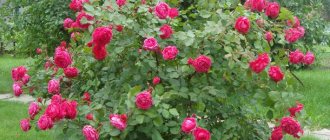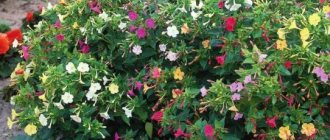Decorative and unpretentious chamomile chrysanthemums can easily decorate any garden. Thanks to its many positive qualities, this plant has become widespread and has been successfully grown for decades in many regions of the country. Moreover, almost all varieties are undemanding and get along well in any weather conditions.
The variety of varieties of chamomile chrysanthemums allows them to be successfully used in landscape design
What are the names of chrysanthemums that look like daisies?
Daisy chrysanthemums belong to the Asteraceae family, which originally appeared in Asian countries and were used as indoor plants. At the end of the 18th century, flowers were brought to Europe, where they gained popularity as a garden crop.
Chamomile-shaped chrysanthemums are presented as perennial shrub plants with umbrella-shaped inflorescences, visually reminiscent of chamomile flowers, which became the reason for their simple name among gardeners. Scientifically, this species is called Chrysanthemum morifolium, which means “sun flower”, “golden flower”. Flowers are also divided into varieties with a specific name, which can have different inflorescence shapes: semi-double and non-double (simple).
Types of asters: classification
“Star”, and this is how “aster” is translated from Latin, can decorate the garden for most of the season - right up to frost. It’s not for nothing that its other name is “autumn rose.” To choose “your” aster, you should approach the choice wisely. And for convenience, use the classification. Asters of different types differ from each other according to the following characteristics:
1. By flowering time:
- early - bloom 80-110 days after emergence;
- average - after 115-120 days;
- late - after 120-130 days.
2. According to the height of the bush:
- dwarf and low-growing ones (25 and 35 cm, respectively) can be used to decorate flower beds or grown in flowerpots behind the balcony;
- tall (70-150 cm) – suitable for cutting to make bouquets;
- universal (40-70 cm) - good both in a bouquet and as decoration in a flower bed. They are distinguished by powerful peduncles and large inflorescences.
3. According to the structure of the inflorescences:
- tubular - consist only of tubular flowers;
- transitional - tubular flowers in 1-2 rows framed by reed flowers;
- reed - there are either no tubular flowers at all, or they are hidden from view by reeds.
Annual reed asters have their own classification.
4. According to the shape of the inflorescences:
- needle-shaped;
- single, single;
- coronoids;
- semi-double;
- curly;
- spherical;
- imbricated.
What do chamomile chrysanthemums look like?
Chamomile chrysanthemums are diverse in appearance and are represented by different varieties, but the flowers have common features:
- stems are thick, erect and leafy;
- leaf blades are large with jagged edges;
- umbrella-shaped inflorescences;
- flowers have reed, marginal, tubular type petals, arranged in one or several rows;
- petiolate, dissected leaves;
- the root system is fibrous;
- Up to 20 inflorescences can be formed on one stem.
All types of chamomile chrysanthemums bloom profusely. The flowering time of those varieties that are intended for cultivation in open ground is usually about ten weeks after the appearance of the first flowers. Indoor species with proper care can bloom all year round.
Attention! Flowers stand for a long time after being cut without losing their external qualities.
What is the difference between chrysanthemum and chamomile?
Chamomile and chamomile chrysanthemum belong to the same Asteraceae family, but regardless of this they have only a visual similarity. Otherwise, these two types are different.
Chrysanthemums and daisies have the following significant differences:
- height and size of the bush - daisies grow no more than 60 cm in height, since chrysanthemums can reach up to 1.5 m;
- color - white petals and a yellow core are considered a classic color, which is precisely characteristic of daisies, while chrysanthemums are represented by a more extensive color palette;
- flower diameter - chamomile flowers are much smaller, equal to no more than 2.5 cm;
- flowering period - daisies are considered summer plants, since their flowering occurs in July and ends in September, while chrysanthemums delight with flowering until late autumn.
The extreme petals of chrysanthemum flowers can be arranged in several rows, unlike chamomile
We don’t have any irreplaceable ones: doubles of flower annuals
We continue to study one of the most interesting topics on the site - twin plants for all occasions of country life.
And today it’s time to pick up a pair of annuals. Twin plants of flower annuals
Selecting doubles will give you the opportunity to replace plants of similar habit (appearance) if necessary. May my fellow botanists forgive me for taking a little liberty - in some pairs I added perennial and biennial flower crops to the annuals, which are grown as annuals. Particularly interesting in this regard were the various varieties of garden chrysanthemum, which became partners with asters, zinnias, marigolds, and so on.
Aster or Callistephus chinensis, photo by the author. Garden chrysanthemum variety 'Emily', photo by the author
But I won’t keep you waiting any longer, and if you’re ready to put together plant puzzles, let’s get started.
Argyranthemum frutescens - crowned chrysanthemum (Chrysanthemum coronarium)
A wonderful pair of everyone’s favorite “daisies”. And she is far from the only one: plants of similar habit are easy to find among the popular flower crops from the Asteraceae family.
Argyrantemum shrubby, photo by the author. Chrysanthemum crowned, photo by the author
On the Southern Coast of Crimea (SC), Argyrantemum shrubby winters in open ground. For information on how to grow it, see the article on the website Argyrantemum: flowering that lasts a whole summer. You can get to know edible chrysanthemums and the peculiarities of their cultivation in the post Edible chrysanthemums.
Aster, or Chinese callistephus (Callistephus chinensis) 'Dragon select fawn' – garden chrysanthemum Chrysanthemum) 'Queen Mary'
The variety of varieties of both annual asters and garden chrysanthemum will allow you to choose an endless number of pairs.
Astra 'Dragon select fawn'. Photo from the website biotechnica.ru. Garden chrysanthemum 'Queen Mary', photo by the author These pairs will help you prolong flowering in a mixborder in late summer - early autumn. Moreover, no one will notice the substitution. Unless only the treacherous tart aroma of a chrysanthemum you accidentally touched will reveal the replacement of the “player”.
Aster, or Chinese callistephus (Callistephus chinensis) 'Winter cherry' - perennial daisy (Bellis perennis)
If you pair daisies similar to them with annual asters, then the decorative period of the flower garden can be shifted in the other direction - to early spring. And then, with the onset of heat, when the daisies have faded, aster seedlings are planted in the vacant places.
Astra 'Winter Cherry'. Photo from the website cemkin.ru. Perennial daisy, photo by the author Aster seedlings have well-branched roots, so they are easily restored when transplanting even almost flowering specimens (of course, you still need to act as carefully as possible!). For both crops, open sunny places with fertile, well-drained soils are good; they are responsive to feeding.
Common basil (Ocimum basilicum) – Perilla frutescens var. crispa, syn. var. nankinensis)
Two very similar spicy plants. If you are in doubt which one is in front of you, just rub the leaf. In the aroma of basil you will feel a combination of cinnamon, anise, citrus, cloves and mint, which altogether create its unique smell. Perilla leaves are much more modest in terms of aroma: only notes of cinnamon can be heard in it.
Common basil. Photo from the site sortseeds.ru. Nanjing bush perilla, photo by the author
Marigolds (Tagetes) 'Fantastic orange' – garden chrysanthemum (Chrysanthemum) 'Astro Bronze'
With marigolds and chrysanthemums you can create more than one pair of doubles. Thanks to their interchangeability, summer in your sunny mixborder will linger until the beginning of warm autumn.
Marigolds 'Fantastic orange'. Photo from seedspost.ru. Garden chrysanthemum 'Astro Bronze', photo by the author
High-quality seedlings, healthy rooted cuttings, fertile, well-cultivated soil, watering, weeding, fertilizing - these are the components of the success of beautiful flowers.
Marigolds (Tagetes) 'Vanilla' – Zinnia
This pair is interchangeable crops that bloom at the same time. Your doubts (who is who) will once again be dispelled by the specific aroma of Tagetes.
Marigold 'Vanilla'. Photo from the site 1semena.ru. Zinnia, photo by the author
To this pair, like most annuals, we owe the beauty of our summer flower beds. It is thanks to their spectacular abundant flowering that our dachas turn into oases of joy and happiness.
Hybrid verbena (Verbena x hybrida) – Drummond's phlox (Phlox drummondii)
A very successful pair of charming annuals.
Verbena hybrid. Photo by the author. Phlox Drummond. Photo by the author
They grow and bloom beautifully in sunny places with well-drained soil (for example, in rockeries), but do not tolerate overheating of the roots. Propagated by seeds through seedlings; sowing in March.
Hybrid Gaillardia x hybrida – Helenium autumnale
In pair with the sultry annual beauty that lights up the flower beds in summer, I placed a similar perennial that will pick up the bright baton of its flowering in early autumn.
Gaillardia hybrida, photo by the author. Helenium autumn. Photo from villaved.ru
For abundant flowering of both, you need plenty of light and nutrients in the soil. Both representatives of this bright pair are quite drought-resistant. On the site about the first culture, see the material Elegant gaillardias.
Delosperma cooperi - crystal mesembryanthemum (Mesembryanthemum crystallinum)
This pair of relatives from the Aizoaceae family can also be supplemented with Dorotheanthus.
Delosperma Cooper. Photo from worldofsucculents.com. Mesembryanthemum, photo by the author
These are wonderful exotic plants. As annuals they are good in sunny rockeries. They are moderately static. Propagated by seeds through seedlings in cold greenhouses. Naked slugs don't like them.
Dimorphoteca pluvialis - osteospermum
Even professional flower growers confuse these annuals, which is not surprising, because they are exactly similar to each other.
Dimorphotheca rain. Photo from exotic-plants.de. Osteospermum, photo by the author
For information on growing osteospermum, see the article Starry Summer of Cape Chamomile or Osteospermum on the website, and information about dimorphotheca rainfly can be found in the post Annuals - a simple way to decorate a flower garden.
Cosmos bipinnatus 'Snow click' – garden chrysanthemum (Chrysanthemum) 'Zembla White'
Amazingly, amazingly similar to each other during flowering! Summer residents who are planning to create a white garden should definitely pay attention to them.
Cosmea 'Snow Click'. Photo from seedspost.ru. Garden chrysanthemum 'Zembla White', photo by the author
Both crops must be fed carefully and in moderation. With an excess of organic fertilizers, plants actively increase the lush mass of greenery, and flowering suffers.
Dark purple scabiosa (Scabiosa atropurpurea) – seaside Armeria (Armeria maritima)
Previously, I always confused these two beauties from afar, but now I know how easy it is to distinguish them: I clearly focus on the time of year. The perennial armeria blooms first (in May), and then (from July to September) the annual scabiosa.
Varieties of chamomile chrysanthemums
Chamomile chrysanthemums are presented in a wide variety. Thanks to the work of breeders, gardeners can choose the most suitable type of this crop, which will fit perfectly into any landscape design.
Ariel
The Ariel variety is a white bush chamomile chrysanthemum, which is very similar in appearance to the field representative of the Astrov family. The bush reaches only 80 cm in height, the petals are snow-white, the center is golden yellow. The only thing is that the petals are arranged in several rows and the size of the flowers themselves is much larger than an ordinary chamomile - it can be up to 12 cm in diameter.
The variety is an early flowering variety, the first buds begin to bloom in July
Bacardi
The Bacardi variety has non-double flowers, smaller in diameter than the previous type and only about 5 cm. The bush is tall with strong, very flexible stems that are not prone to fractures. The color varies from white to burgundy. Inflorescences consist of 5-8 buds.
Flowers of the Bacardi variety can retain their original appearance for two weeks after cutting.
Evening lights
The Evening Lights variety is a low-growing species, reaching a height of no more than 40 cm. Flowering is abundant, it is characterized by small red buds up to 5-6 cm in diameter with a yellow core.
The Evening Lights variety has an underdeveloped root system
Hebe
The Hebe variety is a late-flowering species. The shrub is medium-sized, up to 50 cm in height. The petals are arranged in a single row, gathered towards a bright yellow core. The flowers have a lilac or crimson hue and are about 7 cm in diameter.
The core of flowers of the Hebe variety is convex
Teddy bear
The Teddy Bear variety has semi-double small flowers up to 4 cm in diameter, with red-orange petals arranged in several rows. The height of the bush is about 55 cm. It blooms later - from October to November. This small chrysanthemum, like a daisy, is called Teddy Bear precisely because of the lush flower, as if made of plush.
The core of the flower in the Teddy Bear variety is hardly noticeable due to the multi-row arrangement of the petals
Coreopsis
With a flower shape reminiscent of cosmos, coreopsis exists in many varieties, but almost all of them are yellow. In a smaller assortment, there are those in which the golden-sunny tone is combined with dark red, as well as pink and white-red.
And before decorating your garden with a certain variety, it is important to clarify whether the coreopsis variety has its own unique preferences. For example, coreopsis:
- large-flowered - requires minimal soil moisture;
- pink - flowers lose their decorative appearance on fertile soils;
- whorled - will bloom profusely and for a long time if pruned after the first wave of flowering;
- lanceolate - flowers respond positively to the application of organic fertilizers.
To preserve their decorative appearance and maintain vitality, coreopsis plants, with the exception of whorled ones, should be divided and replanted every 3 years.
Reproduction methods
Chamomile chrysanthemums, like most cultivated plants, can be propagated in several ways. The most common method is cuttings, and the simplest is dividing the bush. But growing through seeds is a labor-intensive process that takes a lot of time and effort.
Cuttings
Chamomile chrysanthemum cuttings are harvested in the autumn, when the plant is pruned for the winter. Healthy stems up to 7 cm long, which should have 2-3 buds, are chosen as planting material. The finished cuttings are first placed in a growth stimulator, then sent to water or prepared soil. As soon as root branches appear, the seedlings are placed in a cool place until spring. In May, young plants are planted in open ground.
Dividing the bush
To propagate chamomile bush chrysanthemum at home by division, you need to choose a healthy mother plant that is at least two years old. The bush is carefully dug up and its root system is divided into several parts. Each “daughter” plant is immediately planted in a new shaded place.
Attention! Dividing a chamomile chrysanthemum bush is carried out not only for the purpose of reproduction, but also in order to reduce root growth.
Seed method
The seed method is usually used when propagating annual chrysanthemum species. To do this, planting material is prepared after flowering and dried. You can also stratify the seeds to increase their chance of germination.
Planting material is sown in specially prepared nutrient soil. The container is covered with film or glass to create a greenhouse effect. Periodically, the cover is removed for watering, ventilation and condensation removal. Irrigation is carried out using a spray bottle.
Shoots should appear after 14-15 days. Then, after the formation of two full-fledged leaves, the sprout is picked and transplanted into a separate container.
Advice! To increase the chance of seed germination, you can use additional lighting with a UV lamp, as well as fertilize with complex fertilizers at least once every two weeks.
In spring, sprouts can be planted in open ground. If the temperature does not allow it, then it is best to initially transplant the seedling into a greenhouse so that it becomes stronger for growing in the garden.
Petunia
Shade is contraindicated for this flower in the area, and it also needs regular weeding, loosening and mulching of the soil for proper breathing of the root system.
In addition, petunias need potassium supplements once every 2 weeks all summer until August.
Petunia varieties are in great demand among gardeners:
- Flame - red flowers adorn the bush from June to September, the variety is distinguished by its demands on long daylight hours and tolerates drought well;
- Stormy sky - cream-colored inclusions are scattered across the purple velvety petals in dots and strokes;
- Jolly lemon yellow - attracts with its unusual yellow color for petunias and the fact that the compact bushes are densely strewn with flowers. The variety is not afraid of windy and rainy weather.
Even for the southern regions, it is recommended to grow petunia through seedlings - by providing the plant with ideal conditions in the early stages of its life, you can easily keep it in the garden in the future.
Planting and caring for chamomile chrysanthemums
Chrysanthemums, similar to daisies, which have an identical name among gardeners, do not have specific planting and care features. The young plant is planted in open ground in compliance with the timing and certain growing conditions.
At home, they usually choose propagation by cuttings or dividing the bush.
Terms and conditions of cultivation
Chamomile chrysanthemums are usually planted in the spring. In different regions, planting time may vary from mid-May to early June. If you need to plant seedlings in open ground in the fall, you should choose a time at least a month before the onset of the first frost.
The location for the future chrysanthemum should be sunny and slightly elevated to prevent moisture stagnation. The holes are prepared small, about 30 cm in depth and in diameter. Drainage material is placed at the bottom. If it is necessary to plant several bushes at once, then they are placed at a distance of 20-30 cm from each other (for tall varieties it is recommended to maintain at least 40-50 cm).
How to plant correctly
The algorithm for planting chamomile chrysanthemum is quite simple and consists of the following steps:
- Preparing the hole.
- When the hole is ready and the drainage layer has been completed, planting begins. A little fertile soil mixture is poured over the drainage, then the seedling is placed, straightening the roots well. Sprinkle with substrate, tamp lightly and water.
- On the day of planting, it is recommended to fertilize the young plant for better rooting.
- To speed up flowering, at the time of planting, the first pinching of the chamomile chrysanthemum is performed, carefully removing the growth point of the shoots.
Aftercare
Caring for chamomile chrysanthemums involves watering, fertilizing and preparing for winter.
Watering is carried out periodically when the upper layers of the soil dry out. As a rule, watering in hot weather is carried out three times a week strictly at the root of the plant. After moistening the soil, it is recommended to fertilize with a potassium-phosphorus complex.
Attention! During flowering, watering must be reduced to 1-2 times a week.
2-3 weeks after planting a chamomile chrysanthemum seedling in open ground, you can make a second pinching, removing the tops with 2-3 nodes from new shoots.
As soon as the leaves begin to wither and dry out in the fall, this means that the plant is ready to rest. Therefore, it is necessary to start preparing chrysanthemums for winter. To do this, the bushes are pruned, leaving the stems about 10 cm. For the southern regions, it is enough to mulch the bush, but in the northern regions it is recommended to cover it with sawdust or spruce branches.
Astra perennial
If you foresee that there will be nowhere to put seedlings at home, and there will be no place for them in the greenhouse, then opt for perennial asters. They can be planted either in seedlings or without seedlings.
The first two years, seed germination is good, then it drops by half, and in the fourth year the seeds will simply remain in the ground.
Perennial asters can be propagated by dividing bushes (as most gardeners do) or by cuttings.
They also need to move, but for a different reason than annuals. Perennials grow very quickly, so to rejuvenate they need to be replanted every 3-4 years.
Annual asters bloom in the 3-4th month after planting; perennial asters show off buds only in the next season.
What plants are combined with?
Chamomile chrysanthemums are usually used in landscape design for group planting together with other low-growing crops. Flowering bushes also look great when planted in the border.
Low-growing varieties are excellent for composition with small coniferous and deciduous trees, and they also harmonize well with marigolds, coleus, balsam and zinnia. In combination with asters and hydrangeas, chamomile chrysanthemums can be planted against the backdrop of evergreen bushes.
Chamomile chrysanthemums are often used to create mixborders
Daisies
Graceful daisies can fit into absolutely any style of landscape design. White varieties can serve as a backdrop for colorful arrangements, such as pansies, while pink daisies pair beautifully with ferns. Hyacinths, forget-me-nots and crocuses can also become spectacular neighbors for daisies.
When caring for daisies in the garden, it is important to adhere to the following rules:
- water them in a timely manner, preventing the soil from drying out;
- prevent strong growth of biennials, replacing them with young plants;
- regularly loosen the soil to prevent crust formation;
- apply fertilizers that promote the production of color pigments.
Daisies tolerate frost well, the main thing is to insulate them with breathable coatings that do not allow them to damp out. Spruce spruce branches with a top layer of fallen leaves are suitable.
Variety of shades
Asters are characterized by a rich color palette. These plants are also distinguished by a variety of colors in the wild. And in breeding forms they amaze with their splendor. There are flowers of various shades:
- white;
- yellow
- red;
- blue;
- purple;
- lilac;
- pink
- lilac;
- salmon;
- cream;
- yellow.
Bi-color and tri-color varieties combine these colors in various combinations, creating unusually attractive combinations. But carmine-red and snow-white asters, the most common and popular, are considered classic.











